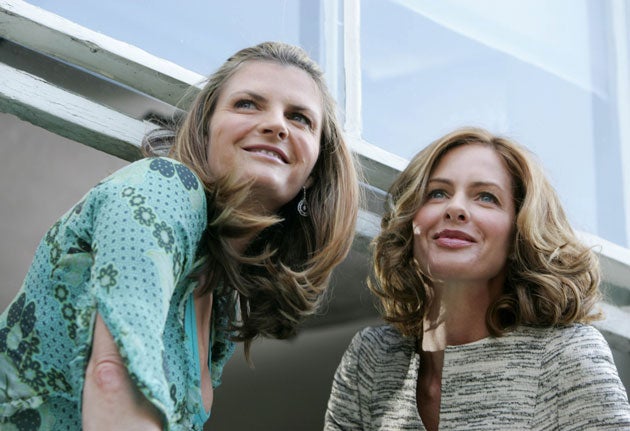Trinny and Susannah slide out of fashion
They were queens of the makeover show, and a generation of women trusted their style advice. So what caused Trinny and Susannah's crowns to slip?

Trinny and Susannah might have made the television makeover show a primetime staple, but it appears that their no-nonsense fashion formula is struggling to compete with a new era of fashion TV. The rumour mill is in overdrive this week with talk that ITV may axe the duo after viewing figures for their current show, Undress the Nation, fell sharply; it's been attracting just 2.5 million viewers (11 per cent of the available audience) in recent days.
When Trinny and Susannah first hit our screens with What Not To Wear in the early Noughties, their dominatrix-style bossiness and tendency to grapple with women's breasts as part of their programme of public humiliation seemed daringly abrasive. Now, compared with some of the makeover shows following in their kitten-heeled footsteps, their formula seems like old-fashioned, no-nonsense innocence.
Like the public-school nurse whose remedy for everything from a broken leg to bipolar disorder is carbolic soap and a plaster, Trinny and Tranny (as they have been unkindly nicknamed) pronounced a well-fitting bra the panacea to all life's sartorial mishaps. There was no figure too lumpy, skinny or lanky that couldn't be improved with a few stern words from Trinny, a good old grope from Susannah and some hardcore corsetry.
And for the icing on the cake, the duo would dress their subjects up in an approximation of their own west London yummy-mummy uniform of velvet or lace-edged cardigans, bias-cut dresses, chunky necklaces and tasteful natural-look make-up.
However, these days, on more radical makeover shows such as 10 Years Younger, a less than perky bust is solved with breast implants, crooked teeth with cosmetic dentistry, and wrinkles with chemical peels. T&S's reassuringly wholesome attitude of "make do and mend" when it came to image has been replaced by a disturbing agenda of radical transformation. Why make the best of yourself, some shows seem to ask, when you can remodel your face and body? On one episode of the cable show Extreme Makeover, a participant's family barely recognised the subject post-beautification – and this was considered a good thing.
T&S's reluctance to promote cosmetic surgery is admirable, but their endeavours to move with the times by choosing to get under their subjects' skins psychologically rather than physically haven't been entirely successful. Perhaps it's just not such good entertainment any more?
When the duo moved from BBC1 to ITV in 2005 as part of a reported £1.2m "golden handcuffs" deal, they had to not only rethink their successful makeover show format, but also consider a way to compete with the new extreme makeover culture now popular in other programmes.
Enter Undress the Nation, in which the duo tried to help people by sprucing up their wardrobes. Unfortunately, their assumption that they could heal serious family issues with a new wardrobe marked the apex of their hubris – and the beginning of their fall from grace.
Undeterred, the pair embraced a new deal to be the public face of the catalogue company Littlewoods, providing fashion advice for the home-shopping masses. Before long, the pair were designing their own clothing range for the brand, based around their twin obsession with body shape and proportion.
T&S's attitude to clothes has always been matter-of-fact, and based on problem-solving. Indeed, Susannah described their Littlewoods fashion range as "prescriptive clothing". In truth, their philosophy owes rather more to a homespun fusion of colour science, physiology and geometry. They have previously identified women's bodies as "cornet", "apple" or "goblet" shapes, among others – and they have advised women how to dress appropriately rather than following trends or encouraging self-expression.
With the growth of fashion both on the internet and in weekly fashion magazines, most women are now self-taught experts on clothes. High-street collaborations have introduced designers who might once have been seen as avant-garde to the mainstream, and even the cheapest weekly magazines explain how to recreate Balenciaga on a budget. Shoppers at large are still firmly in the grip of celebrity-inspired looks and the latest trends.
Of course, T&S's lack of interest in trends, designer labels and self-expression left a vacancy for the new TV messiah of the mass market – Gok Wan. With a vocabulary that's a cringe-inducing mix of Absolutely Fabulous!, Ricki Lake, Page 3 and QVC ("Nice bangers!", "Babygirl!", "You go girlfriend!", "Statement piece!"), Gok has managed to capitalise on the public's desire for catwalk looks at high-street prices. On Gok's Fashion Fix, his sidekick Alexa Chung interviews designers such as Roberto Cavalli and Jean Paul Gaultier, while Gok spends his time searching for a street style icon. This fusion of the high end and the attainable is much more in tune with the zeitgeist than T&S's approach.
Of course, since David Cameron has made it OK to be posh again, the duo may be better off returning to their original, hearty head-girl appeal. Because, as the latest viewing figures show, right now their attempts to follow a more "everywoman" approach just aren't working.
It's fashion by numbers, and this time the figures aren't adding up.
Join our commenting forum
Join thought-provoking conversations, follow other Independent readers and see their replies
Comments
Bookmark popover
Removed from bookmarks